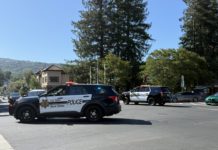
Council got its first chance to go over changes the Town is considering making to its traffic-related development fee structure, last week, and members were quite surprised at some of the details.
The Traffic Impact Policy was introduced in 1991 and the current version is based on how many Average Daily Trips new builds would add to Los Gatos—charging $1,015 more each time one is added.
That works out to 9.44 trips per single-family residence ($9,581.60), for example.
There’s been a shift in the urban planning world to a new method of calculating how much to levy on developers to cover the increased transportation burden their projects will bring: Vehicle Miles Traveled (VMT).
Some jurisdictions have embraced VMT as a way to wean themselves off a reliance on gas taxes.
The U.S. Department of Transportation notes that if you can decrease VMT (per capita), you’ll not only improve air quality, but you’ll also boost the overall health of the population.
It points to a 2004 study out of Atlanta, Ga. that found every extra hour someone spent in a car led to a 6 percent increase in obesity risk.
California has tied VMT to environmentalism, and it has become a key metric in looking at how to reduce roadway congestion and eliminate greenhouse gas emissions.
But for Los Gatos, how it integrates VMT into its planning will directly affect how much money it has on hand to deal with the problems that will inevitably crop up on the roads, bike paths and sidewalks as the community continues to grow.
In 2020, the Town switched to using VMT figures in the Traffic Impact Policy. But it has yet to update the fee structure.
That’s what Council was investigating during its regularly scheduled May 2 meeting, clearly weighing the effect each rate adjustment could have on encouraging or blocking construction.
What it boils down to, according to Los Gatos Parks and Public Works Director Nicolle Burnham, is the Town must update these fees if it wants to realize its municipal planning dreams.
“This Town has adopted a pretty ambitious program for transportation improvements,” she said, noting there will be plenty of education needed to explain why the status-quo isn’t considered good enough anymore. “Tonight is really our first ‘dipping our toe in the water’ of outreach.”
Los Gatos turned to DKS Associates in 2022 to undertake a “nexus study” to help it figure out how to develop a reasonable relationship between new development and desired public projects.
There are two components to Los Gatos’ draft Traffic Impact Program—a Transportation Improvement Fee, to collect funds for things like roads, bridges and signal lights, and a VMT Reduction Fee, which would bring in revenue to be put towards reducing the amount people drive (this could mean charging for parking to fund bike lanes or sidewalks).
Here, however, the ongoing referendum campaign that has reverted the density regulations in the adopted 2040 General Plan (to the levels in the prior plan)—for the time being—managed to rear its head, once more.
Planners had been in the middle of developing the new development fee policy when the referendum proponents energized anti-growth forces in town, suspending the Community Design and Land Use elements until residents have their chance to vote directly on these guiding documents.
Burnham explained that staff chose to stick with the 2040 General Plan projections, stating that fees would actually be higher if the referendum succeeds.
Los Gatos has $192 million-worth of transportation infrastructure it wants to build.
That includes Blossom Hill Road and Union Avenue intersection improvements, Los Gatos Boulevard widening (Samaritan Drive to Camino Del Sol) including new sidewalks and bike lanes, a Winchester Boulevard and Lark Avenue intersection upgrade, and a new pedestrian and cyclist path as well as a bridge for the Highway 9 / Los Gatos Creek Trail connector.
Los Gatos thinks it can get $149 million from grants and other sources.
So, that leaves $43 million that it still has to come up with.
Staff explained that the maximum a single-family home builder could be charged under the proposed fee structure would be $36,090.
“What do we have the appetite for as a Town?” she asked. “You can adopt different levels.”
Commercial would actually see a reduction, because these developers would get credit for “pass-by” trips, where motorists don’t actually enter certain properties, she added (a drop from $2.1 million to $1.1 million for about 40,000 square feet of retail).
Councilmember Rob Rennie noted that there’s a lot of uncertainty with the projections, since if just one item on the list changes, that could totally change the entire plan.
He pointed to the Highway 17 / Highway 9 congestion improvement project—which currently features a $111 million price tag alongside $100 million-worth of grants.
Burnham said that project seems like it’s going to for sure happen.
Councilmember Matthew Hudes struck a familiar chord when he asked whether the estimates were based on the total possible build-out figures (the ones focused on by referendum supporters) or the probable development numbers used in the 2040 General Plan.
The DKS rep, appearing over Zoom, said they relied on the numbers in the General Plan as a “reasonable estimate.”
Councilmember Rob Moore worried that the rates proposed for multi-family units are so high they’d prevent affordable housing from being built.
“If I’m a developer and I see this sheet, I’m going to cross Los Gatos off my list,” he said, sharing a back-of-the-envelope calculation that a standard 50-unit development would see a-quarter-million-dollars in traffic fees. “I think that this would be a big constraint.”
This turned out to be the rare land-use matter where he found common ground with Vice Mayor Mary Badame.
“I just don’t know where to go with these fees,” she said, suggesting a credit program for deed-restricted housing. “We’re just kind of all over the board.”
Mayor Maria Ristow explained she sees this exercise as a balancing act.
“We certainly don’t want to set barriers,” she said, while noting that someone has to foot the bill for proper transportation infrastructure so traffic isn’t a nightmare. “If nobody has to pay for it, then we don’t get it.”
Staff said they would incorporate the feedback received from Council into tweaks they’ll make to the plan in the coming weeks.










Your ongoing characterization of the referendum and its sponsors as “antigrowth” is both disingenuous and dishonest. The referendum is a Constitutional Process where the Los Gatos Citizens decide the Growth Plans for Los Gatos! Bureaucrats in Sacramento do not dictate to Los Gatos Citizens!
Since your Canadian Citizenship prevents you from understanding Our Constitutional God Given Rights. I suggest you refrain from editorializing and just report the facts if you can!